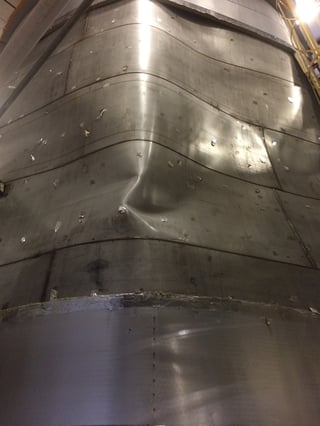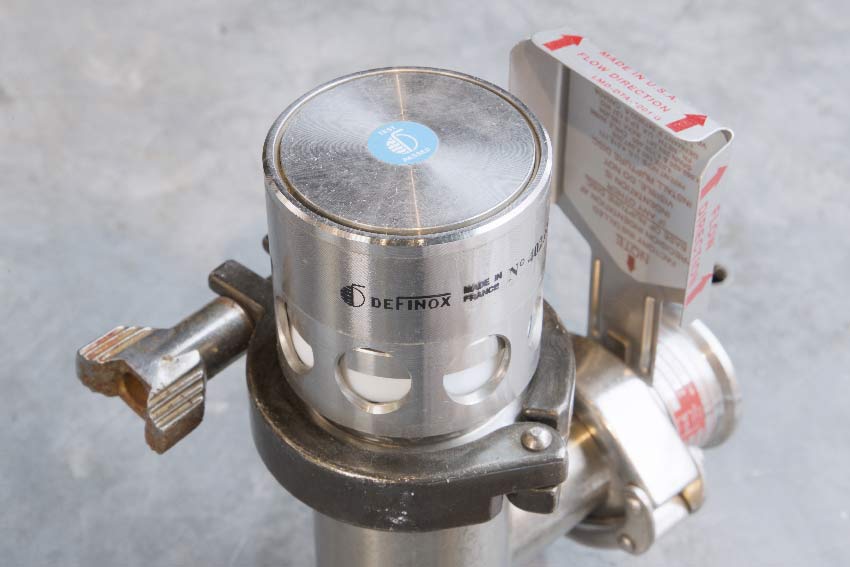What is Vacuum Pressure
Vacuum pressure occurs if your tank is poorly vented or the relief valve is malfunctioning. The pressure within your fermenter or bright tank will drop, causing a pressure differential between your tank's internal pressure and the atmospheric pressure. When that pressure differential becomes greater than the external pressure rating of the tank, the vessel will experience catastrophic failure. The end result is almost always a complete loss and high replacement costs.

How Does Vacuum Failure Happen
The threat of vacuum failure inside a brewery is very real. Many of the day-to-day jobs in your operation create conditions that can directly lead to vacuum failure. Those activities include:
Pumping or draining an unvented tank
As you pump or drain a tank you are removing beer but not allowing any air to enter the tank. As your tank continues to empty the small amount of CO2 or air in the tank has to fill up the void created by the emptied beer. This creates a low pressure environment in the tank and the weight of the atmosphere will implode the tank.
Overfilling a Tank
If you overfill a fermenter or a bright tank to the point where beer fills the vent line you can create a siphon. Much like pumping or draining an unvented tank, beer will siphon out without allowing air to enter the tank. Once enough beer has siphoned out the vent line your tank will crumple under the weight of the atmosphere.
Hot CIP followed by cold rinse
After you clean a fermenter or bright tank the air inside of the tank is very hot. If your rinse water temperature is too cold it could cause a very rapid drop in pressure within the tank because cold air is much more dense than hot air. When you crash the air temp inside an unvented tank, the tank can implode in an instant!
Using Caustic Soda After Fermentation
It is common practice to clean a fermenter once you have moved the beer to a bright tank. A byproduct of fermentation is CO2. If you introduce caustic soda to a fermenter full of CO2, a chemical reaction will occur, converting the gas CO2 into a solid. This will lower the pressure inside of your fermenter and, if it isn't vented properly, can lead to vacuum failure.
The Importance of a Vacuum Relief Valve

A vacuum relief valve protects your tanks from vacuum failure by allowing air into your tank when the inside pressure starts to drop. Your fermenters and bright tanks are an important investment for your brewery. Not only are they costly, they enable you to create the beer your customers love to drink. The best way to keep your tanks in service is to install a properly sized vacuum relief valve.
Buying the right sized vacuum relief valve is an important step. They are not one-size-fits-all. Because tanks are all engineered differently and no two breweries use the exact same cleaning regimen, the valves are usually sized for your unique application by the valve manufacturer.
Different Types of Vacuum Relief Valves

Vacuum relief valves come in a variety of shapes and sizes. Depending on the application, they can use spring-loaded resistance or a weight-loaded resistance. Some manufacturers offer a valve that can protect from both vacuum and pressure. These pressure/vacuum relief valves (PVRV) keep your tank from imploding as well as exploding outward from too much internal pressure.
Vacuum Relief Valve Inspections
Your vacuum relief valves are useless to you if they are not working correctly. It is important to regularly inspect your valves. During the initial usage phase, you should inspect your valves more frequently than you think is necessary. The idea is to discover a potential problem before it becomes a real problem.
When inspecting your valve, make sure it is being cleaned properly during clean-in-place and that it is still able to mechanically function properly.


